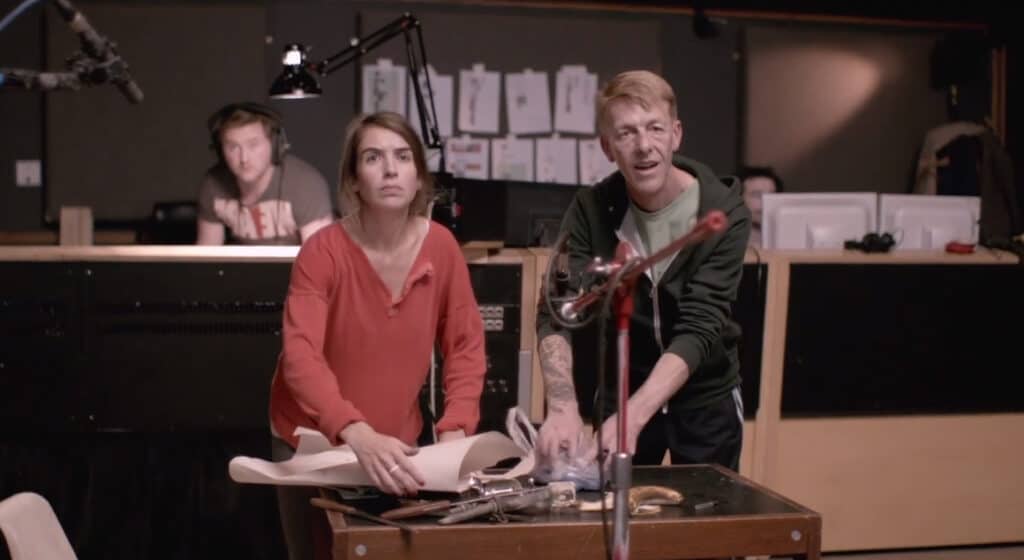Foley
DAWN CHORUS – A must Look and Listen to for Sound Designer

DAWN CHORUS – A must Look and Listen to for Sound Designer
In the exceptional situation of the “Corona-Spring 2020”, a new international citizen science project invites us to record and share the sounds of the Dawn Chorus.
Join the worldwide dawn chorus for the sciences and the arts. The Corona pandemic has caused a severe global crisis. The dramatic silencing of human activities that it has caused is also making the voices of nature resound on an unprecedented scale. In this unique situation in the spring of 2020, the idea was born to make the birds’ voices heard. Your local recordings for the DAWN CHORUS will be mapped worldwide.
The collected recordings of the dawn chorus can provide valuable information about the diversity of species, the behavior of the birds, as well as the effects of climate change and habitat loss on the populations. Last but not least, they reveal a lot about the effects of the noise of human civilization on the life of the birds.
Under the circumstances of this memorable spring of 2020, the idea for this Citizen Science project was born – inspired by the work of the American musician, bio-acoustician and artist Bernie Krause, the founding father of soundscaping.
In cooperation with many figures from science, culture and the digital world, and now emerging on the initiative of BIOTOPIA and the Nantesbuch Foundation, a new Citizen Science platform has been developed which will invite people to contribute Dawn Chorus recordings from May 1until May 22 2020 (International Day of Biological Diversity).
The platform www.dawn-chorus.org aims to survey the dawn chorus of birds worldwide, to encourage people to take an interest in protecting their local biodiversity, and to make this data usable for science in understanding, for example, the impact of climate change and other factors on bird biodiversity. In cooperation with artists, further dimensions of processing and communicating the results will be explored.
Foley
A Beginner’s Guide to Starting a Career in Foley
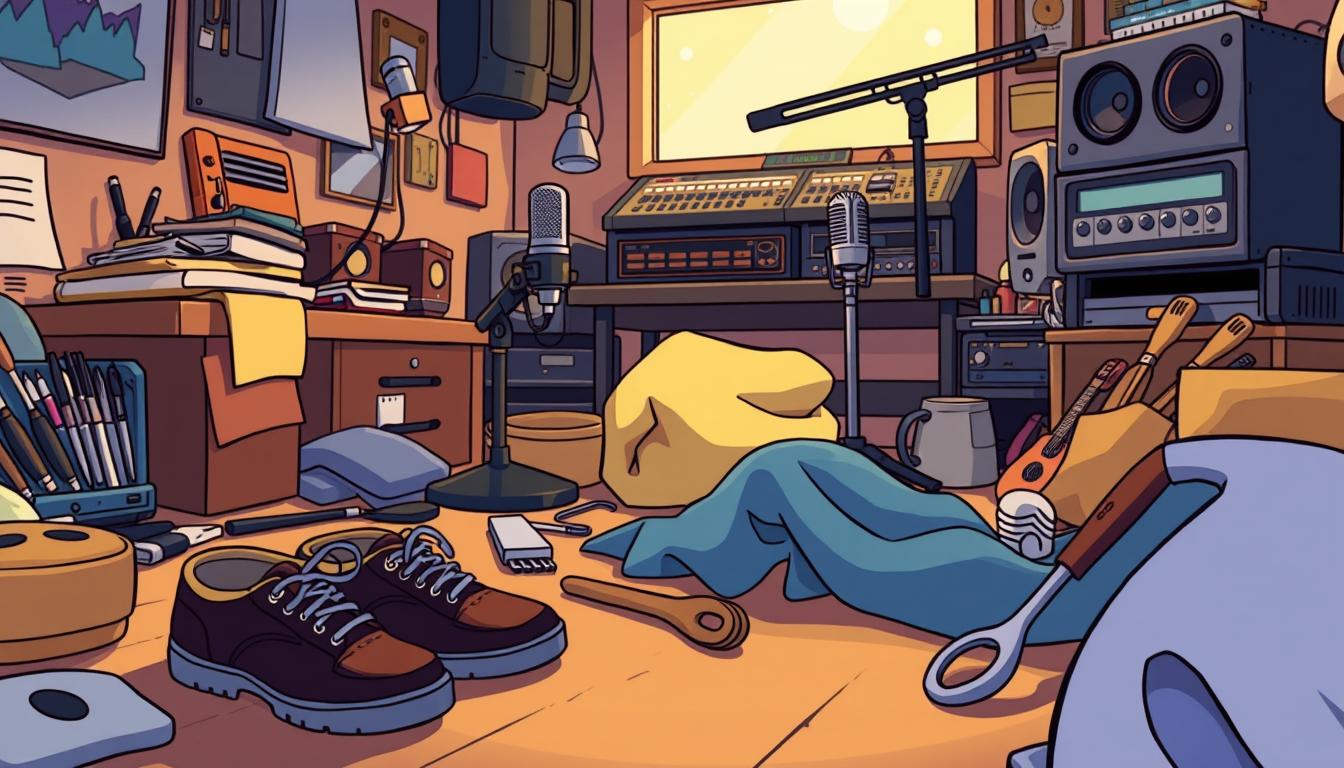
Imagine you’re in a dark theater, eyes glued to the bright screen. You’re taken to another realm, not just by visuals but by sounds. The rustling leaves, soft steps, and distant roars engage you. This magic comes from Foley artists. If creating these sounds excites you, you’re in the perfect spot. This guide introduces you to Foley, a key part of film sound. It’s your first step into a creative career full of highs and lows. By learning the basics, you begin a thrilling journey.
Key Takeaways
- Foley artistry adds depth to movie and TV storytelling.
- Foley Artists typically make about $450 for an 8-hour workday.
- Union Foley Artists might get $400-450 daily, whereas non-union artists could make around $200.
- Success in this field often means juggling various projects.
- Editing in Foley is just as important as recording for impacting viewers.
- Knowing the technical bits of Foley work can really boost sound quality.
Understanding the Role of a Foley Artist
A Foley artist is key in movie and TV post-production. They recreate sound effects. This Foley artist job description includes making and recording sounds that boost the audience’s experience. They use live methods instead of pre-recorded sound libraries. Foley artists use props and techniques for real-sounding audio. This audio matches the action seen on screen.
Foley artists use many tools, from daily items to specially made tools. They capture sounds for different scenes. Sounds like footsteps, clothing rustles, and even big events like fights are recreated. This process takes creativity and skill. Each sound must make the story feel real.
Foley artists work closely with sound editors. This team effort makes sure the sound fits the visuals and enhances the story. Editing Foley material often takes as long as it was recorded. This means a day of recording can lead to a day or more of editing. This careful editing helps sound effects blend smoothly.
| Foley Sound Creation Process | |
|---|---|
| Stage | Activities |
| Recording | Utilizing various props to record live sounds |
| Editing | Refining and adjusting sounds for precise alignment with visuals |
| Collaboration | Working closely with sound editors to ensure cohesion |
| Review | Final checks for quality and impact on the audience’s experience |
Foley artists add to scenes in ways often unseen. Yet, their work helps viewers dive into the movie’s world. Their mix of sound design and skill is vital in today’s films.
The Importance of Foley in Film and Television
Foley sound adds depth and realism to movies and TV shows. Named after Jack Foley, it makes scenes feel true to life. Sounds like footsteps and rustling clothes help tell the story better.
Foley is also key in voice acting. It keeps characters’ actions sounding vibrant and real. Movies like The Lord of the Rings and Toy Story show how important sound is. The right sound at the right time makes everything more impactful.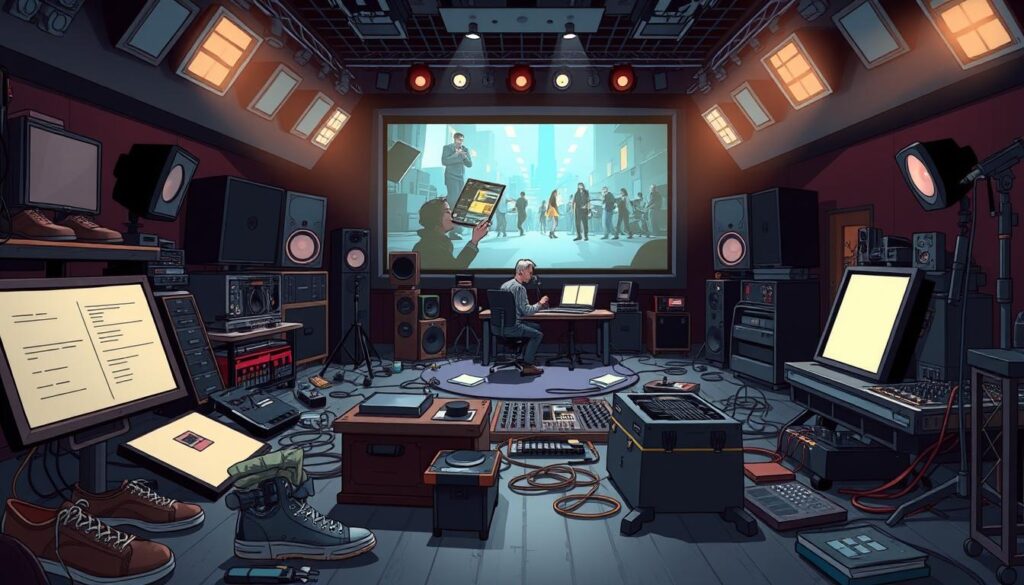
To make Foley sounds, artists use props and body movements. High-quality mics and software are important too. Recording good sound effects takes skill and the right tools.
One common mistake is using too many sounds. It’s also important to match the timing of sounds with the action. Learning from resources like “The Art of Foley” or YouTube can help improve skills. Understanding Foley’s role can deepen your appreciation for film sound.
Skills Required for a Successful Foley Career
To become a great Foley artist, you need many skills. These skills mix technical know-how and creative flair. Starting with a strong base in Foley skills is key. Important qualities include:
- Creativity in Foley helps you invent unique sounds. These sounds make stories come alive.
- Being detail-oriented is important. This makes sure every sound fits perfectly with what’s seen on screen.
- Inventiveness is key for making unusual sounds. Think of the sounds from mythical creatures or exciting chases.
- Good teamwork skills help you work well with directors and sound teams. Together, you create amazing soundscapes.
Foley artists recreate sounds that make movies feel real. Sounds like footsteps and ambient noise are their focus. They often work with tight deadlines and must be quick. This is why being disciplined and responsible is crucial.
Working well with others is must-have. You’ll work closely with the film team and actors. You’ll use props and surfaces to make sounds. Paying attention to how you make these sounds is key.
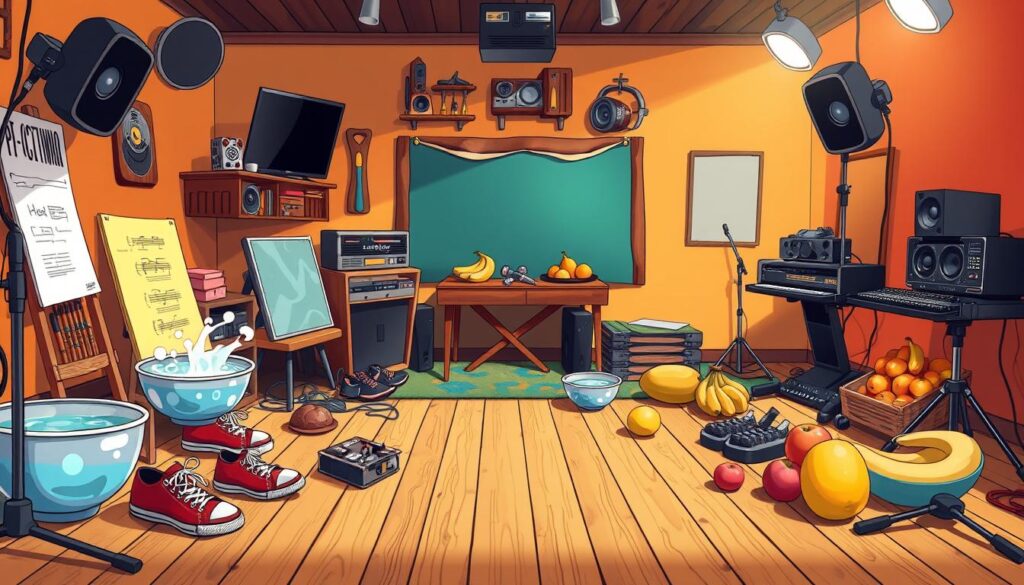
Having a portfolio is a smart move. It should show off your Foley skills and creativity. Networking in the industry is also important. It can open doors to many jobs in audio post-production. While degrees are helpful, showing off your talent is usually more important.
A Beginner’s Guide to Starting a Career in Foley
Starting a career in Foley is thrilling. It’s full of creativity and technical puzzles. Knowing the steps to become a Foley artist will guide you. Each phase is key to growing your skills in this absorbing area.
Key Steps to Enter the Field
To get into Foley, consider these steps:
- Learn the Basics: Get to know sound production. Focus on sound’s role in visual stories.
- Seek Entry-Level Opportunities: Hunt for starter jobs in sound effects or design teams. This helps you learn the ropes.
- Engage in Volunteer Work: Use your skills on indie films or community projects. It’s a great way to see Foley in action.
- Internships: Look for internships. They let you watch pros like Foley Artists. You’ll learn lots this way.
- Network: Make industry friends. Go to events, join film groups, and meet sound designers. Learning from them is priceless.
- Continuing Education: Think about studying sound design more. Formal courses can boost your knowledge and skills.
As you follow these steps to become a Foley artist, stay passionate. Every bit of experience helps you grow. This lets you flourish in this artistic field.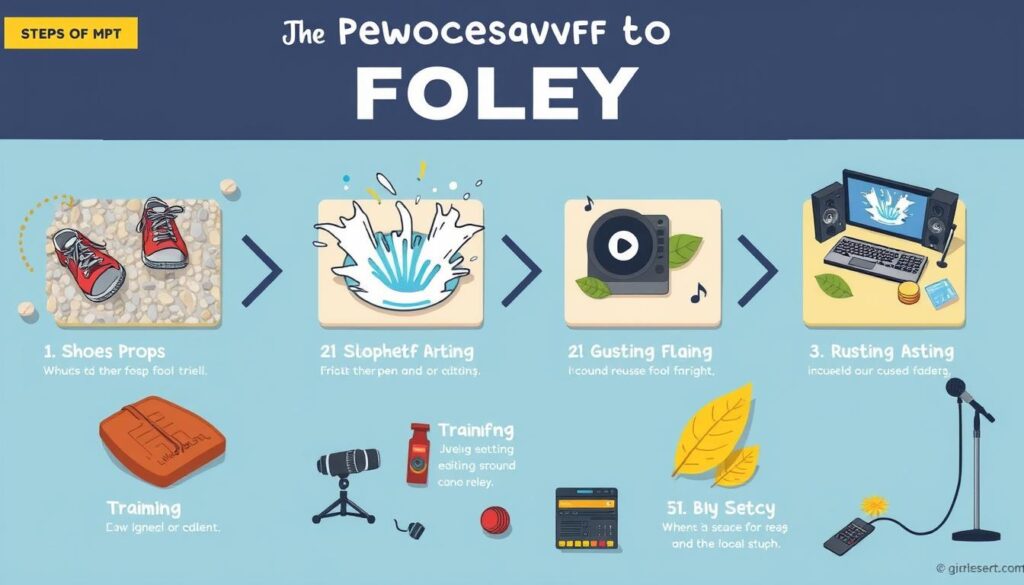
Education and Training Opportunities
Pursuing formal education can make a big difference if you want to be a Foley artist. Foley education programs help you learn more about sound design. You also get to practice in a real setting. Film schools offer experiences that blend theory with practical work. This mix gives a well-rounded education.
Film Schools and Sound Programs
Look for film schools and sound programs with a strong audio production curriculum. These programs cover:
- Sound design basics
- Hands-on work on Foley stages
- Team projects with students and the community
- Using professional tools like Pro Tools and Logic Pro
Online courses on platforms like Udemy and Coursera let you learn at your own pace. Podcasts like The Tonebenders Podcast and Twenty Thousand Hertz share tips from pros. Joining online communities keeps you up to date and inspired.
Jobs in sound design include Sound Designer, Foley Artist, Composer, and Audio Engineer. Each job needs specific skills. Film school can help you develop these skills.
| Resource Type | Examples |
|---|---|
| Film Schools | USC School of Cinematic Arts, NYU Tisch School of the Arts |
| Online Courses | Udemy, Coursera |
| Digital Audio Workstations | Pro Tools, Logic Pro, Ableton Live |
| Sample Libraries | Spitfire Sound, Native Instruments, Output |
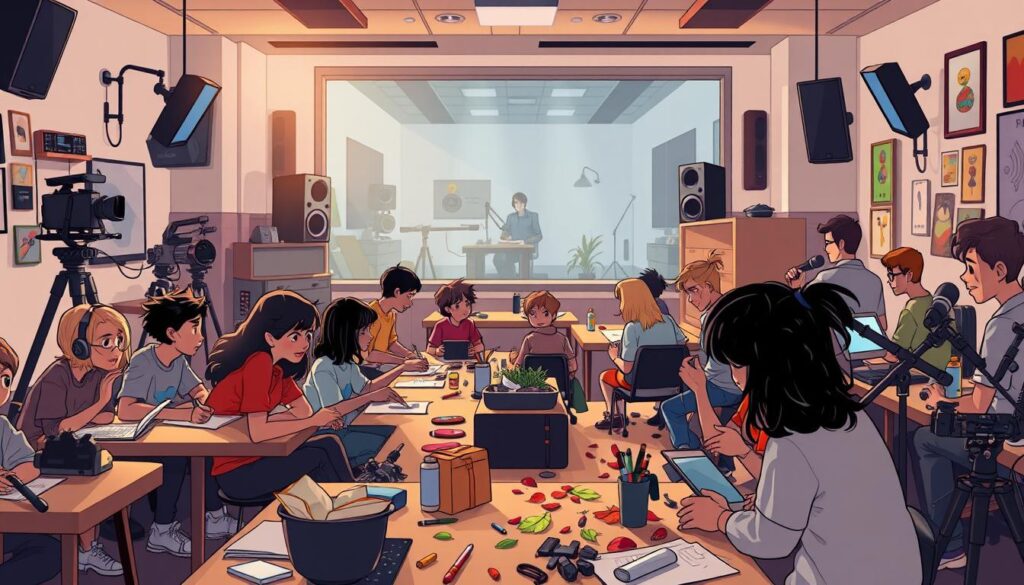
Networking and Building Professional Relationships
In the competitive world of Foley, networking in Foley is key for career growth. Building professional relationships opens doors to new job chances, mentorships, and team-ups. You should start by going to film festivals and workshops. Here, you’ll meet experienced pros face-to-face. Connecting with people in your field can make lasting sound industry connections.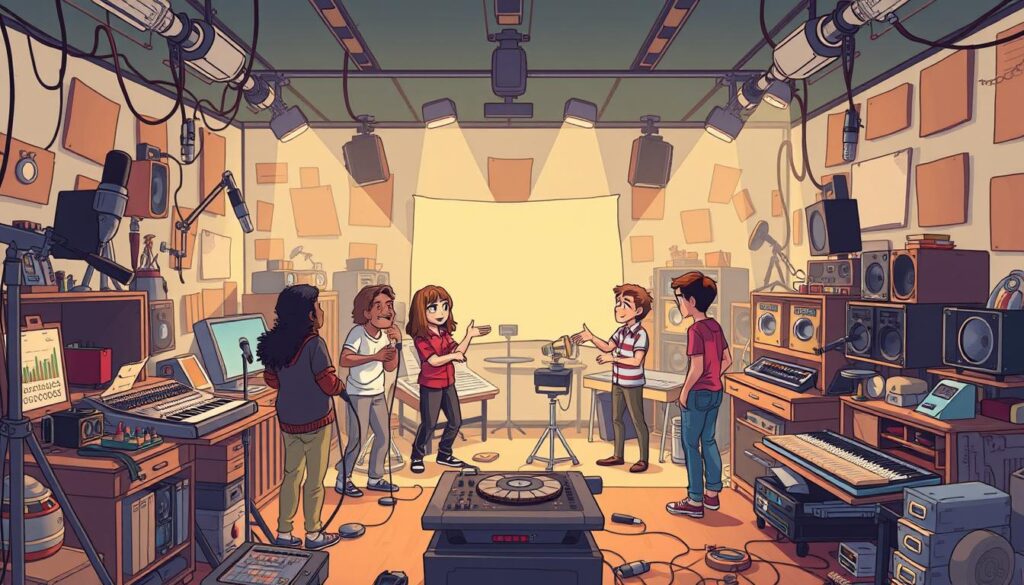
Being part of groups in sound design and Foley is helpful. These organizations give you resources and support from a community of peers. Also, use online networks like LinkedIn to meet leaders in your field. And keep your profile current. Recruiters look online for candidates, so having a sharp online presence is vital.
- Participate actively in career fairs to meet potential employers.
- Utilize your existing networks, such as program coordinators and alumni, for job leads.
- Create an engaging elevator pitch to introduce yourself and your skills effectively.
- Practice elegant social media etiquette to maintain a professional image.
Many Foley artists say their success comes from strong professional bonds. Such connections lead to more work and deeply affect your career’s direction. To keep these relationships strong, keep in touch and value collaborations. This approach can pave the way for a successful career in Foley.
Gaining Experience Through Internships and Entry-Level Positions
Gaining practical experience is crucial for a successful career in Foley. Engaging in Foley internships offers aspiring artists a chance to dive deep into sound production. This hands-on experience helps you polish your skills besides working with pros. This is key to becoming great at the craft.
Volunteer Work and Apprenticeships
Volunteering or apprenticeships also provide valuable sound production experience. Many sound facilities look for newcomers eager to help in various roles, starting from the ground up. Common positions include:
- Production Assistant (PA): A role that provides a basic understanding of the industry by supporting daily operations.
- Intern: Interns do tasks like PAs, sometimes for school credit, instead of pay.
- Assistant: This job involves giving technical help to engineers and mixers.
- Sound Editor: Involves editing dialogue, sound design, and doing Foley tasks.
- Engineer: Focuses on recording voice-overs, ADR, and Foley tasks.
- Sound Supervisor: Manages sound processes and schedules for smooth post-production.
- Re-recording Mixer: Mixes different audio parts to create a unified sound.
Entry-level positions in sound emphasize the importance of starting low to build trust. Employers value candidates who show strong work ethics and passion for sound. Recommendations and networking are vital for securing these jobs. Studios prefer hiring those ready to start at the bottom. They appreciate the commitment to learning sound production deeply.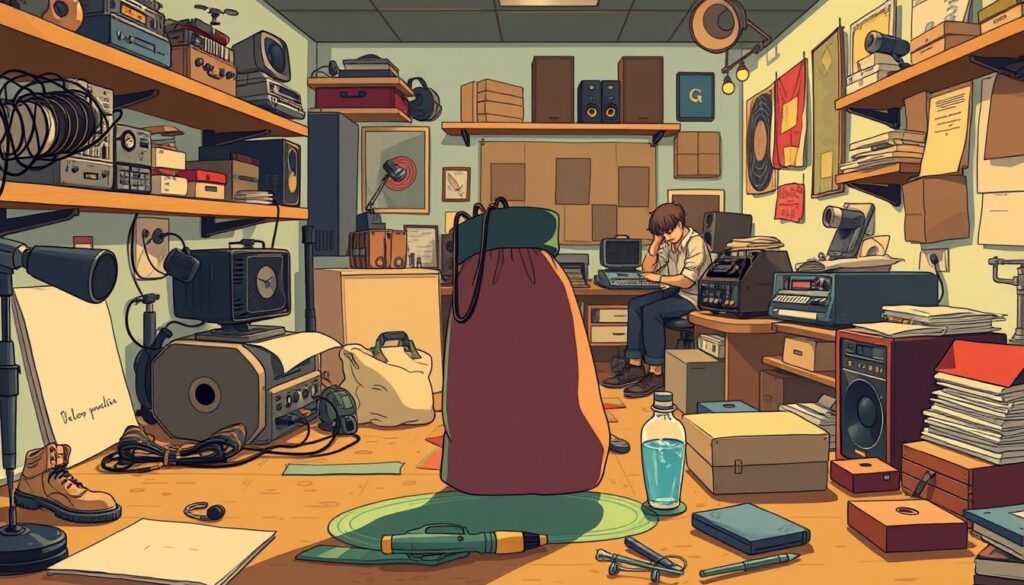
The Technical Side of Foley Production
Grasping the technical side of Foley Production is essential for those aspiring to excel. Knowing about Foley stages—the special areas to create sound effects—is crucial for quality audio. It’s important to be familiar with the equipment used in sound production.
Understanding Foley Stages and Equipment
Foley stages are key to crafting the rich sounds in movies and TV. Each stage has gear for recording sounds like cloth, footsteps, and other props. When working, keep in mind these points:
- Tracks for Cloth Recording: Aim for one track, but up to four can work well.
- Diverse Clothing Options: Use about 20 different clothes in the Foley studio and refresh them as needed.
- Microphone Distance: Keep microphones 1 to 1.5 meters away for cloth sounds, and up to 3 meters for certain textures.
- Recording Duration: Expect to spend around twelve hours on cloth tracks for TV shows, more for complex projects.
- Microphone Types: Shotgun mics are good for recording cloth, especially in studios without perfect acoustics.
The editing part of Foley takes longer than recording. The Foley editor plays a big role in ensuring everything sounds right. Key parts of editing are:
- Syncing the start and stops of moves accurately.
- Keeping internal phases aligned.
- Fixing any issues with cloth sounds and removing unwanted noises.
- Dealing with low-frequency rumbles and other stage noises.
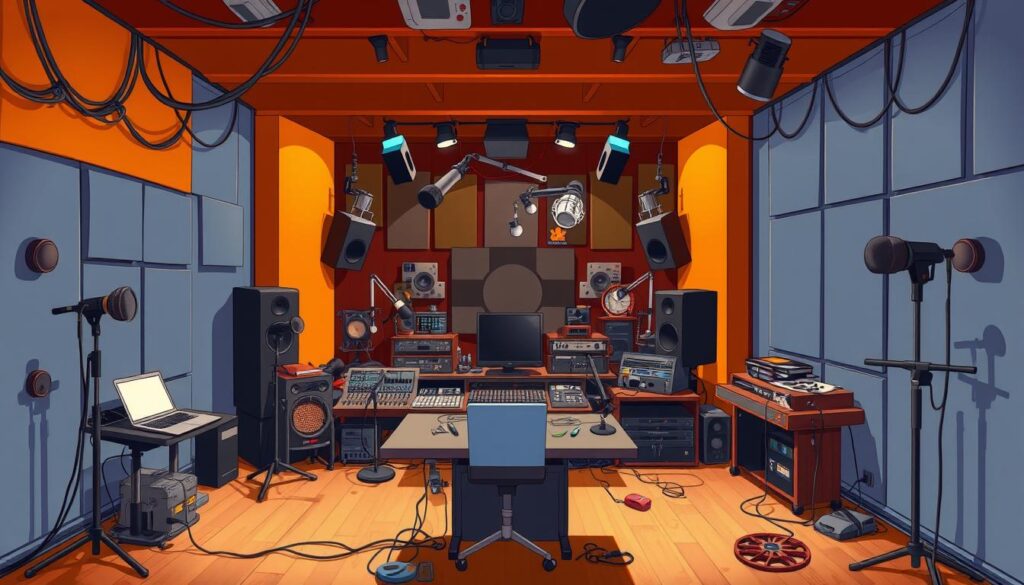
Learning the technical aspects of Foley and mastering production equipment will up your audio game. Knowing your tools and environment boosts your work’s quality, opening up creative possibilities.
Tips for Aspiring Foley Artists
Starting your journey as a Foley artist is both exciting and rewarding. Here are some tips to help you succeed and improve your skills. These will also boost your chances in your Foley career.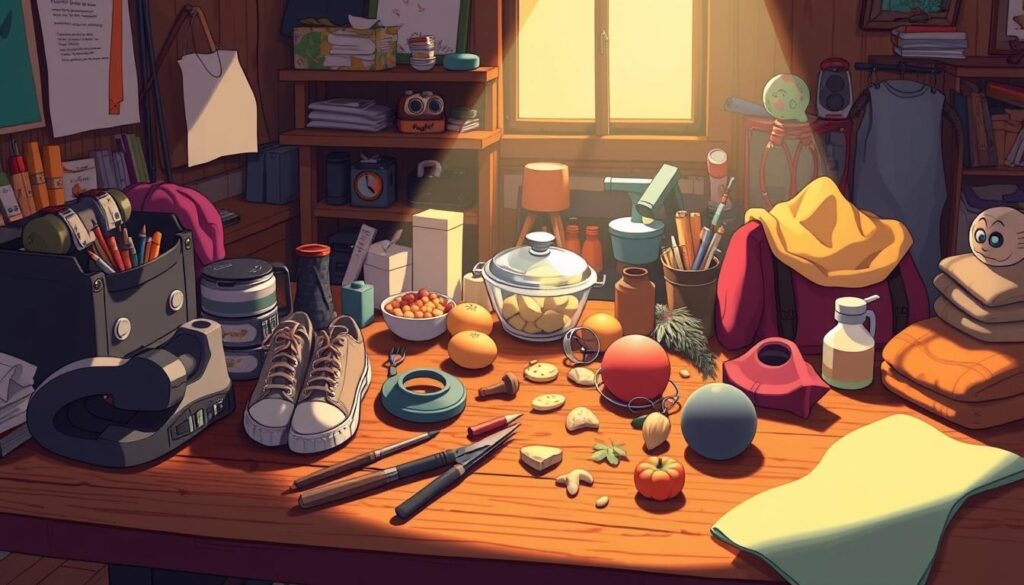
Practice is key. Try out different materials to make unique sounds. You’d be surprised at the sounds everyday items can make when you’re creative.
- Develop your artistic style: Being unique can help you stand out. Add your personal touch to sounds for fresh results.
- Build a diverse portfolio: Show your creativity and technical skills. A great portfolio is important for nabbing future work.
- Network effectively: Meeting other professionals can lead to new chances. Go to events, join forums, and take workshops.
- Utilize technology: Learn to use sound software like Pro Tools, Logic Pro, or Adobe Audition. It can improve your Foley work.
- Seek practical experience: Try internships or volunteer work for real-world practice. It builds a strong career foundation.
To wrap up, following these Foley artist tips will help you on your sound design path. Keep learning and stay adaptable as you grow in your career.
Understanding the Salary and Job Market for Foley Artists
The world of Foley artists offers various pay scales. Typically, union jobs pay between $400 to $450 per day. In contrast, non-union jobs pay about $200 per day. This shows a gap in earnings. This gap is due to different factors like the type of project, experience, and union status.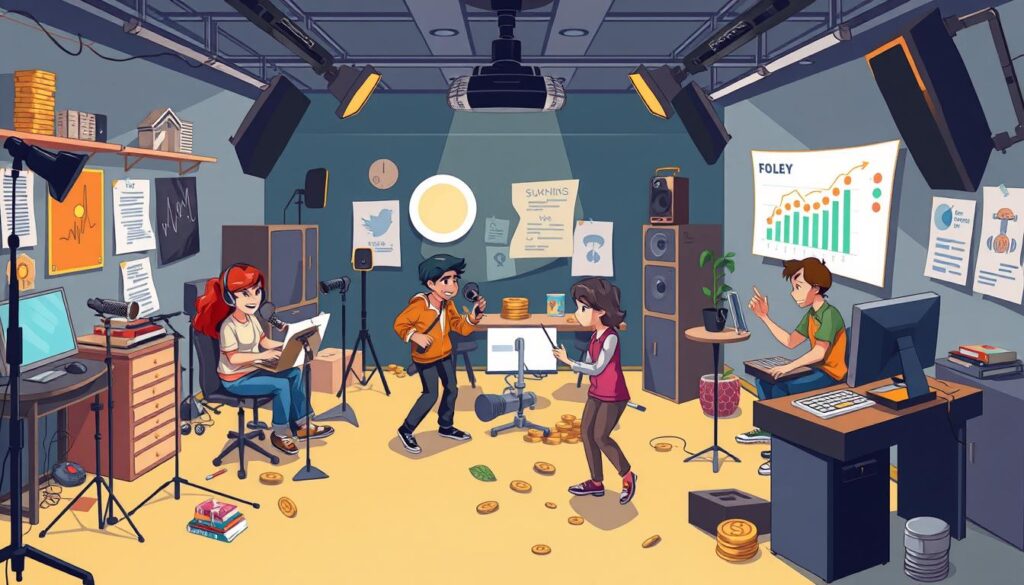
Becoming a Foley artist means entering a tough field. Many experienced artists have strong ties in the industry. This makes it hard for new people to break in. Newcomers often have to work on many projects to earn enough. Their yearly pay depends on these projects.
“Foley artists rely not only on their skills but also on the ability to foster connections within the industry.”
Having an education in sound or music helps a lot. It makes you more employable as a Foley artist. Making connections and gaining experience through internships are key. Working in various types of media, like streaming, has its own opportunities despite often lower pay.
| Experience Level | Daily Rate (Union) | Daily Rate (Non-Union) |
|---|---|---|
| Entry-Level | $200 | $200 |
| Mid-Level (5+ years) | $400-$450 | $200 |
| Highly Experienced | $450+ | N/A |
For a Foley artist, being able to communicate is crucial. It helps in working with sound teams and networking. Creativity and patience help in creating unique sounds. This highlights the creativity needed in Foley work. Understanding the salary and market conditions helps aspiring artists succeed.
Conclusion
As you start your career in Foley, know that it’s all about passion and skill. This guide has taught you how important technical abilities, creativity, and working together are in sound design. You’ve discovered key methods to make your Foley work stand out, like syncing sounds just right and editing footsteps smartly.
Joining the sound design world takes more than just knowing your stuff. It’s about being eager and devoted. Working well with others and staying disciplined will help you grow. Finding new techniques and sharpening your skills will keep you excited about your work. As you dive into Foley, make sure to connect with others in the field. Working together can open up amazing chances and lead to great ideas.
Never forget, staying persistent is key to making it in this creative career. Always meet deadlines and keep talking to your team. If you’re ready to work hard and keep learning, you’ll move forward in your Foley career. You’ll truly make your mark in the world of sound design.
FAQ
What does a Foley Artist do in film and television?
Why is Foley important in the audio production process?
What skills are necessary to become a successful Foley Artist?
How can I start a career in Foley?
Are there formal education options for aspiring Foley Artists?
What role does networking play in advancing a Foley career?
How can I gain practical experience in Foley production?
What technical knowledge should I have in Foley production?
What tips can you offer for aspiring Foley Artists?
What is the average salary for Foley Artists?
Expert Guides
Foley Sound Effects

Foley sound effects are used to produce everyday sounds for use in film, television, and other media. These sounds are recorded in a recording studio and sometimes used in comedy or action scenes. The sounds are added to improve the audio quality of media. Foley sound effects can add depth and realism to a film or TV show.
Foley is the reproduction of everyday sound effects
Foley artists have a wide variety of creative tools available for the reproduction of everyday sound effects in films. Whether it is a crackling sound from a fire or the sound of a creaking door, foley artists can recreate a wide variety of soundscapes.
The foley artist uses different materials to create the sounds that they need for a scene. These materials may include gloves with paper clips or a feather duster for bird wings. They may also use a bag of corn starch or crushed pine cones to recreate the sounds of snow crunching or cracking ice. This process is performed in a Foley stage or a Foley studio, where they use different materials for each sound.
It can be used to enhance comedy or action scenes
Foley sound is a type of sound that is created in a recording studio and used to create a variety of effects in a film. These effects can be as simple as footsteps or as complex as glass breaking. Foley artists have complete control over the sound effects and can use different types of sounds and volumes to help the production come to life. Foley sound is made by using a variety of objects and surfaces to create the desired effect. For example, walking on gravel might be used to mimic the sound of footsteps on a dirt path, while breaking a stalk of celery can sound like a bone breaking. The goal is to create sounds that are realistic and enhance the overall viewing experience for the audience. How foley sound is made relies on the skill and creativity of the foley artist to bring the world of the film to life through carefully crafted and meticulously chosen sounds.
Foley sound effects were first used on radio plays during the 1920s. Since phonograph recordings were not high quality and flexible enough, radio studios hired sound effects people to create sounds live. Foley and his small crew synchronized the sound effects with the actors’ motions. Foley worked on movies until his death in 1967.
It is recorded in a recording studio
Foley sound is recorded in a recording-studio, where a foley artist records sound effects. The sounds he or she records are often inspired by dialogue or a musical score, and require a great deal of patience. Foley artists must learn about the character’s movements and the sound they are trying to recreate.
The first step is to gather your props. Wear quiet clothing that will not interfere with the microphones. Then, play back your first cue and see what you can create. Remember, the sound effect must match the actions in the video.
It is produced by rubbing two pieces of material together near a microphone
Foley is an art form that has evolved as recording technology has improved. Rather than recording sound directly on the set, Foley is recorded separately and synchronized with the visual counterpart. Foley artists use their creativity to create these sounds, which give the viewer the impression that the sounds are real. The sound is then added to the film during post-production.
To capture a Foley sound, you first need to prepare the sound effects material you are going to use. It helps to gather as many props as possible, and make sure to wear quiet clothes that will not interfere with the microphones. Then, try playing back the sound effect. Make sure that you use different materials, and experiment with different sounds.
It is a tailor-made sound
Foley sound is a tailor-made audio sound created by a Foley artist. Unlike regular production sound effects, Foley artists don’t use dialogue or other elements from a story. The sound that a Foley artist creates is unique, and the artists are often part of the sound team.
Foley sounds are recorded with a high-quality microphone. Then, they’re imported into the video editing software. They typically have a wide dynamic range, and require volume automation and panning controls. Also, the spatial location of the sound on the screen is important.
Expert Guides
What Are Foley Sound Effects?

Foley is a filmmaking term that describes sound effects added to a film or media in post-production. These sounds can be real or recorded. They are usually added to add quality to the audio. Foley sound effects are also used to make instruments that can be heard in movies. Foley artists use a variety of recording equipment to create custom sounds.
Foley artists create tailor-made sounds
Foley artists create custom sounds for film and television. These artists manipulate objects, such as firearms and tools, to create tailored sounds that match the action on screen. In addition, they must perform the sounds in sync with the scene. Foley artists often create the sounds for cartoons, including “Avatar: The Last Airbender,” “SpongeBob SquarePants,” “Rugrats,” and “Invader Zim.”
Foley artists create tailor-made sounds in a live studio. They position microphones to record different sounds, and edit files for the final mix. If you’re not a professional, you can experiment by creating tailor-made sounds with a microphone and a computer. This will give you a better idea of the process.
For example, a jogger trying to escape from a serial killer needs a sound that conveys a consistent sense of movement, changing perspective, and evocative emotion. It can be difficult to use sounds from library sources in this context, so it’s crucial that Foley artists create tailor-made sounds.
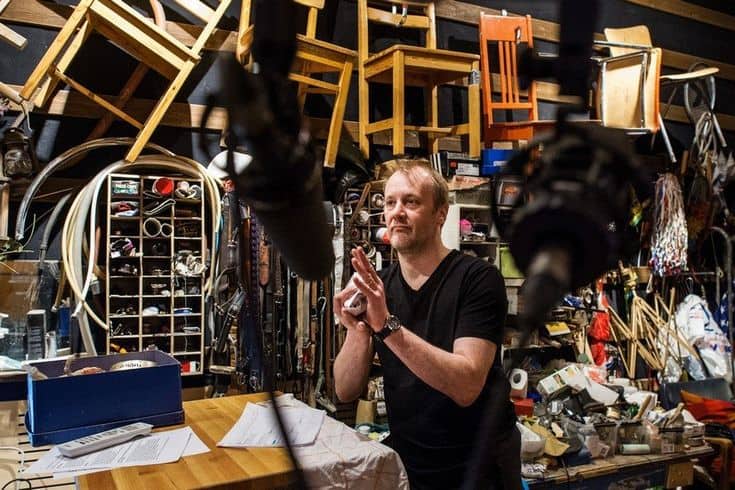
They record them in post-production
Foley sound effects are recorded in post-production after the film is finished, which makes them a vital part of the final mix. These sounds are produced using a variety of methods. Filmmakers often use props and clothing to create the effects. Depending on the type of sound that they want to achieve, they can also use cornstarch boxes to recreate sounds such as snowfall. They can also use old wooden chairs to record sounds related to creaky floors. Likewise, leather gloves or pigeon wings can be used to create different sounds associated with different fabrics.
Foley sound effects are created by recording everyday sounds that are often difficult or impossible to replicate using other means. Foley artists watch the entire film and note what sounds are needed in each scene. They then go back to their studios and collect props that could make the sounds that they are trying to recreate.
They can be recorded in real time
Foley sounds are recorded separately from dialogue. Typically, the actors’ microphones pick up dialogue and other sounds in the background, but the crisp intimacy of Foley sounds isn’t captured. In addition, if actors are turning up the volume on their mics, they may not get the best recording quality. Therefore, recording Foley sounds separately is a better option. It gives the mixing engineer more control over how to mix Foley sounds into the mix.
When recording a Foley sound, the sound artist will imitate a character’s accent, intensity of emotion, and body movement. The sound artist needs to be relaxed while recording in order to pick up the sound of the character. The recording process may take a lot of time.
Foley’s work was influenced by the work of Michael Jackson. He recorded the moves in his hit song “Thriller.” The Foley artists at Skywalker Sound worked on many film productions, including “The Black Stallion.” In addition to using his own props, Foley also utilized a variety of surfaces to record sound. In one of his last Foley jobs, on Spartacus, Foley took a huge ring of keys from his car and jingled them in time with a marching character’s step. This saved two days of shooting with soldier extras.
They can be used to create instruments
Sound effects can be created in a variety of ways, from instruments to subtle movements. Footsteps, for example, are often difficult to record, but Foley recording studios are outfitted with different types of shoes and floor surfaces to create realistic sound. A variety of sounds other than movement are created by lip-syncing to the film image.
Foley sound effects are also commonly used for transitions, percussive layers, and background ambient textures. Samples of these sounds can be loaded into synthesizers or phone recorders to create instrument sounds. For example, an artist can record seagulls and waves crashing to create the vibe of a beach. Background on foley sound effects can be traced back to early film production, where a foley artist would create and record sounds in sync with the action on screen using a variety of props. Today, advancements in technology have made it easier to capture and manipulate foley sound effects for a wide range of audio projects. These sounds add depth and realism to audio productions, making them an essential tool for sound designers and musicians alike.
Foley sound effects are also used for film soundtracks and TV shows. These recordings of everyday items are called Foley sounds. Jack Foley, a sound effects pioneer in Hollywood, pioneered this technique. The term Foley is derived from his name. He was a pioneer of Foley audio and used it to create the sound of muddy footsteps.
-

 Microphone6 days ago
Microphone6 days agoUnleash Your Inner Podcaster: Discover the Best Microphone for Crisp, Clear Audio
-
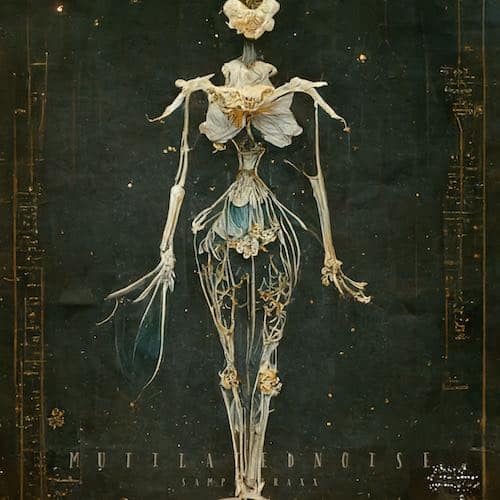
 Composing6 days ago
Composing6 days agoMUTILATED NOISE by SampleTraxx: The Next Generation Sound Collection
-

 Audio Production4 days ago
Audio Production4 days agoUnleashing Sound Therapy: Incorporating Acoustic Design in a Wellness Centre
-

 Singing6 days ago
Singing6 days agoWhat Is Breath Support And Why Is It Important For Singers?
-

 Ambient4 days ago
Ambient4 days agoUnleashing Eerie Waves: A Guide on Producing Dark Ambient Music
-

 Ambient4 days ago
Ambient4 days agoMastering the Art of Dark Ambient Synthesizer Music
-

 SEO3 days ago
SEO3 days agoHarmonizing Holistic SEO for Musicians: Crafting a Path to Digital Triumph
-

 Ambient4 days ago
Ambient4 days agoUnleash Your Creativity: A Complete Guide to Innovating in Dark Ambient Music


